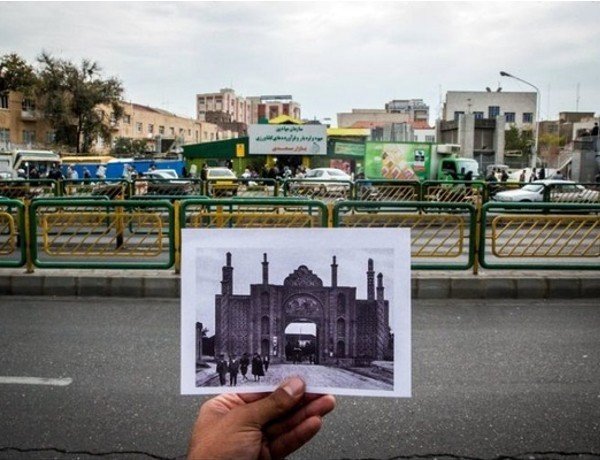
Introduction
Nestled in a busy part of Tehran, Darvazeh Dolat (also known as Dolat Gate) is one of the city’s old gates that once formed part of the urban boundary. Although much of the gate and its surroundings have changed over time, its legacy remains woven into Tehran’s architectural and cultural fabric.
A Glimpse into the Past: Its Architecture & Role
- Historical Context
The gates of Tehran, including Darvazeh Dolat, were part of defensive and administrative infrastructure in earlier periods of city planning. They marked entrance points to the city and guided traffic, trade, and movement in and out of Tehran. (ArastirMax) - Architectural Style & Features
In earlier times, gates like Darvazeh Dolat would have had “gate-house” structures, possibly with archways, decorative elements, and functional space for guards or small gate-offices. They often incorporated traditional Iranian architectural motifs—arches, carved stone or brickwork—and fitted into the city’s walls or ramparts where applicable. While some of that has vanished, historic photos and maps (from late Qajar / early Pahlavi eras) show Darvazeh Dolat among other gates as part of city perimeter. (www.slideshare.net) - Urban Role
The gate served as a waypoint, a boundary between inside and outside, both physically and symbolically. It helped organize streets, markets, and passageways. The marketplaces near Darvazeh Dolat once connected with the gate itself, creating flows of commerce and community activity. (ArastirMax)
The Present Day: What Remains and What’s Changed
- Physical Remnants / Loss
Over time, much of the original structure of the gate has either been lost or altered. The city has expanded far beyond its old walls; many historic gates have been demolished, rebuilt, or their traces removed entirely as urban needs changed. (ArastirMax) - Current Function & Surroundings
Today, the site of Darvazeh Dolat is not a functioning gate or boundary but more an urban node—streets, markets, shops, cafés, transit, and daily life have overtaken the old gate’s purpose. The marketplace near the gate, which once had a strong architecture-market connection, has shifted in its functions: traditional products, workshops, and commercial activity remain, but also modern infrastructure and commercial pressures. (ArastirMax) - Heritage & Preservation Challenges
There are debates and efforts around preserving Tehran’s urban heritage, including gates like Darvazeh Dolat. Some projects address reconstruction of old city gates, or at least preserving their memory in maps, models, plaques, or reconstruction proposals. However, preservation is complicated by urban growth, neglect, lack of funds, and shifting priorities. (SSOAR)
Why Darvazeh Dolat Matters (Especially for Visitors & Local Residents)
- Cultural Memory & Identity: Gates like Darvazeh Dolat are parts of a visual narrative of Tehran’s history: how it grew, expanded, and transformed from a walled city to a sprawling metropolis.
- Architectural Interest: Even if original structures are gone, the layout of streets, old photos, and the surviving marketplace show how traditional architectural and urban design responded to needs of climate, trade, movement, and social life.
- Urban Contrast & Experience: Visiting Darvazeh Dolat area today offers a contrast between old and new — you can sense the layers: what was, what is, and how city life reshapes heritage.
Looking Ahead: Possibilities & Recommendations
- Interpretive Signage & Guided Walks: Install plaques or information boards showing old photos, maps, and stories of Darvazeh Dolat so visitors and locals can connect with what once stood.
- Heritage-Driven Urban Policy: Encourage city planning that protects or restores trace remains, or at least integrates heritage in redevelopment.
- Community Engagement: Local artisans, shop owners, and residents near Darvazeh Dolat should be partners in any conservation or tourism efforts—since their livelihoods relate to the area’s character.
- Digital Reconstruction & Archiving: Use archival materials, photography, and digital tools (VR, AR) to reconstruct virtually how Darvazeh Dolat looked and how the gate interacted with city life.
Conclusion
Darvazeh Dolat may no longer serve as a formal gate, but its presence remains in Tehran’s street plan, marketplaces, and collective memory. For those staying at Azadi Homestay, it’s an opportunity to explore beyond the well-known monuments, to discover corners of Tehran where history is less visible but deeply felt. Whether you’re a lover of architecture, urban history, or cultural heritage, visiting the gate offers insight into what shaped this evolving city.